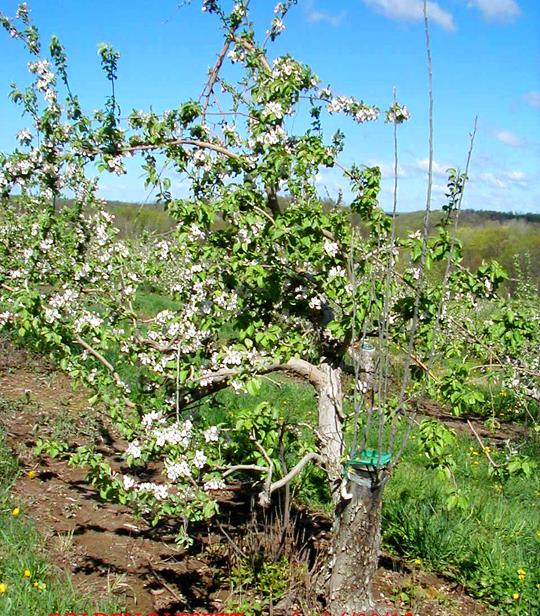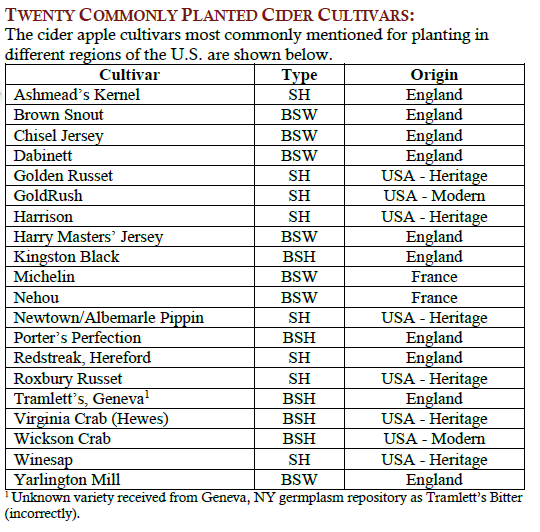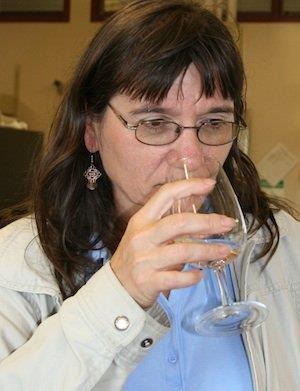Cider Apple Trees – Growing To Meet Demand

There is a growing demand for hard cider in the US, and this is driving a demand for cider apples. Cider consumption in the U.S. grew 10.6 percent per year, on average, or 65 percent overall, from 2011 to 2016. During this same period, beer as a whole was down 1 percent. If that growth rate continues, says Michigan State University researcher Nikki Rothwell, nearly 10 percent of the U.S. apple supply will go into hard cider by 2018. This expanding industry offers opportunities for Wisconsin orchardists to improve their bottom lines by adding a new market for their low value fruit and adding new apple varieties specifically suited for fermentation to meet the demand from hard cider makers in the state.
This was the focus of discussion at the Cider Apple Field Day held on May 10th at Kickapoo Orchard in Gays Mills, WI. Sponsored by the Wisconsin Apple Growers Association (WAGA), the event brought together growers, researchers and thought leaders to tackle the opportunities and challenges offered by this growing industry. Keynote speaker Dr. Carol Miles, shared her knowledge on cider-apple research in Washington State – including information on choosing apple varieties, establishing a cider orchard, and mechanical harvest research. The table below shows the 20 most commonly planted cider cultivars in the U.S.

Dr. Miles presented information from the Washington State University (WSU) research on the growth habits and characteristics of these and other varieties, along with the results of juice analyses and the evaluation of varietal ciders produced at WSU Mount Vernon NWREC. She pointed out that some of the cultivars used for making cider are easier to grow than others: “Factors to consider when choosing cultivars include disease resistance or susceptibility, growth and bearing habit (e.g. tip bearing, biennial bearing), and adaptability to local climate and soil conditions.”

One of the characteristics of many cider apple varieties is biennial bearing. Dr. Amaya Atucha, UW Assistant Professor/Fruit Crop Specialist, provided insight into the phytophysiological factors underlying biennial bearing – most importantly the distribution of hormones. Growers may need to be more attentive to thinning to promote more annual bearing of cider apples.
The research by Matt Stasiak, Superintendent of the University of Wisconsin Peninsula Agricultural Research Station (PARS) aims to provide more information about the suitability of select cider varieties for growing in Wisconsin. He pointed out at the Cider Apple Field Day that research station trials are underway to evaluate 15+ cultivars in terms of their precocity, bloom and harvest dates, yield (fruit, juice volume/weight), biennial rating, cider quality, sugars (% soluble solid, brix), and acidity (pH & titratable malic acid). Outreach specialist Matthew Raboin, University of Wisconsin Center for Integrated Agricultural Systems (CIAS), discussed grants they received to do cider related research at UW. He also shared results from tests conducted at his orchard.
The need for more site-specific research was highlighted Dr. Miles: “Since the best apples for cider making need to be fully mature at harvest, some cultivars may need more heat, while others perform better in cool maritime regions.” This was a key factor in the design of grower field trials funded through the USDA Specialty Crop Block Grant received by WAGA. At the Cider Apple Field Day, each of 10 growers received 15-25 trees to participate in grower field trials of selected cider apples – including five bittersweet, two bittersharp, and one sweet cider variety. Growers will collect and submit data on their efforts using a survey tool developed by Matthew Raboin and staff at the University of Wisconsin Center for Integrated Agricultural Systems (CIAS).
The economics of growing cider apples is a key interest of growers considering this venture. The per acre cost and returns of establishing and producing cider apples in Western Washington State provided growers with a glimpse of what they might consider for Wisconsin. WAGA president Sara Ecker presented a tool that cider makers could use in contracting with growers to grow cider-specific apples. These “grower contracts” are not typically used by Wisconsin apple growers, but are being piloted. Herdie Baisden, program manager for the WAGA Specialty Crop Block Grant, reported on contracting efforts by Kickapoo Orchard and Maiden Rock Winery & Cidery.
Using a template and a sample contract developed by cider and brandy maker Charles McGonegal, ÆppelTreow Winery & Distillery, in Burlington, WI, Kickapoo Orchard and Maiden Rock Winery & Cidery drafted a “contract” that served to guide their discussion and agreements. Maiden Rock provided the scion wood to be top-worked onto Kickapoo Orchard trees. Participants at the Cider Apple Field Day got a chance to see these grafts as they move into the 2016 growing season. Andy Meyer, manager of Kickapoo Orchard, says that the grafts grew so well that he planned to use some of this wood to finish off their grafting in 2016.
These are some of the efforts that can help to reestablish true cider apple varieties in Wisconsin. As Nikki Rockwell emphasizes, the U.S. apple industry not only needs more cider apples, but better varieties. And those varieties need to work for key stakeholders – including cider makers, growers and nurseries.
This article was posted in Apples, WFN, Vol. 1-4 and tagged Apples, Cider, cider apples, Herdie Baisden.
